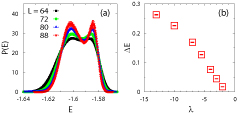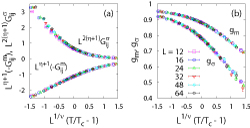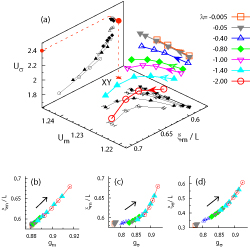Crossover Behavior from the 3D XY Universality in a Frustrated Magnet
Kawashima Group
BaCuSi2O6 is a quasi-two-dimensional frustrated antiferromagnet with body-centered tetragonal (BCT) lattice structure. This compound has a spin gap but it collapses in a strong magnetic field and then the system becomes magnetically ordered. As a result of symmetry of the frustrated BCT lattice, a finite temperature transition to this ordered phase breaks Z2 symmetry in addition to the usual U(1) spin symmetry breaking [1]. The Z2 symmetry breaking is associated with a 90° lattice rotation.

Fig.1. (a) Bimodal energy distribution at T ≈ Tc for λ = -2 and (b) λ-dependence of the latent heat.

Fig.2. (a) “Pseudo-scaling” behavior of correlation functions associated with U(1) (with superscript “m”) and Z2 (“σ”) symmetry breaking with distance rij = (L/2, L/2, L/2) and (b) pseudo-scaling behavior of scaling parameters called “correlation ratios,” which are ratios of the correlation functions with (L/2, L/2, L/2) to those with (L/4, L/4, L/4). Here λ = -0.05 and η and ν are critical exponents of the 3D XY universality class.

Fig.3. The flow diagram of dimensionless scaling parameters (6 parameters in total). (a) A three-dimensional (3D) projection onto (Um, ξm/L, Uσ) space and (b–d) two-dimensional projections are shown. Because of the approximately single curve found in a four-parameter subspace (gm, ξm/L, gσ, ξσ/L), the analysis of the flow structure can be reduced to the 3D flow diagram. The arrows show directions of the flow lines. The estimated location of the unstable XY fixed point (Um, ξm/L, Uσ) = (1.2430(5), 0.5925(2), 2.40(1)) is indicated by a large filled circle. See Ref. [2] for further details.
However, an open question had been left unsettled as to the nature of this phase transition. While experimental observations suggest that the transition belongs to the 3D XY universality class, it was shown that the additional Z2 symmetry breaking changes its nature transition [1]. Indeed, it had been recognized that in contrast to unfrustrated systems, the critical phenomena in certain frustrated systems can be very elusive for the standard renormalization group treatments. For example, the transition of the stacked triangular XY antiferromagnet, where the U(1)×Z2 symmetry breaking appears as in the present case, could be a second order transition described by a “chiral” fixed point although recent numerical simulations are rather in favor of a first order transition.
Here we report on our recent numerical investigation of an effective model with the U(1)×Z2 symmetry [2]. We consider a simple cubic lattice with two sites per unit cell. The sublattice A (B) contains a classical XY spin SA (SB) coupled by the ferromagnetic interaction J. These two sublattices correspond to even- and odd-numbered layers in the BCT lattice (see Ref. [1] for details). The spins in different sublattices are only coupled by the biquadratic ferroquadrupolar interaction λJ (λ < 0). This is the relevant interaction which drives the system away from the 3D XY fixed point λ = 0. This term tends to lock a relative phase between the A and B spins so that SA·SB = ±1 in the ground state, causing Z2 symmetry breaking at the transition.
A very efficient cluster Monte Carlo algorithm is applicable to this system, allowing for a systematic study around the unstable XY fixed point. By performing some standard finite-size scaling analysis, we found that the transition is discontinuous for |λ| ≥ 2 (Fig. 1), while for small |λ| the transition is almost indistinguishable from being second order (Fig. 2).
Given this result, the question that naturally follows is whether the apparent second-order scaling behavior for small |λ| can really be taken as an evidence of continuous nature of the transition. We performed a Monte Carlo renormalization group analysis to clarify this point and the answer turned out to be no. Figure 3 shows the numerically obtained flow diagram. Each flow line describes evolutions of several dimensionless scaling parameters with increasing system size L. Because these scaling parameters become scale-invariant at a second order transition, if there is some λ-region where the transition is continuous, corresponding flow lines must be attracted to a fixed point. However, the flow diagram clearly indicates the absence of such a stable fixed point. The flow lines systematically evolve away from the XY fixed point. Such a trend continues without making a separatrix toward the first-order region, where a flow line with λ = -2 evolves. Thus, our results strongly suggest that the transition is of the first order for any finite value of λ.
In BaCuSi2O6, the biquadratic interaction is expected to be extremely small because it arises from second order perturbation with respect to ratio of a very weak interlayer coupling to an intralayer coupling [1]. Therefore, even though the true asymptotic behavior is the weak first order transition, it can only be observed only in a very narrow region near the transition point which could easily be beyond the standard experimental precision. The thermodynamic behavior outside this small region will be dominated by the XY fixed point, in agreement with experimental observations.
References
- Y. Kamiya, N. Kawashima, and C. D. Batista, J. Phys. Soc. Jpn. 78, 094008 (2009).
- Y. Kamiya, N. Kawashima, and C. D. Batista, arXiv:1003.1639.
